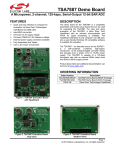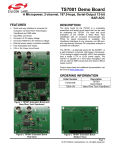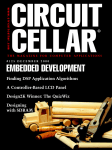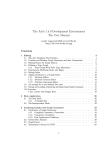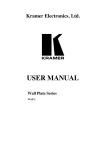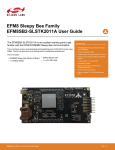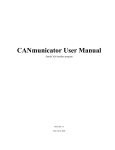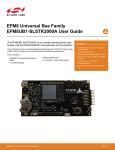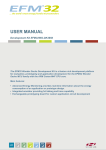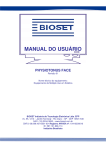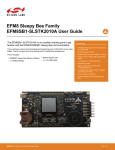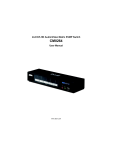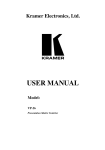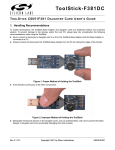Download TS7003 Demo Board
Transcript
TS7003 Demo Board A 300ksps, Single-supply, 12-Bit Serial-output ADC FEATURES DESCRIPTION The demo board for the TS7003 is a completely assembled and tested circuit board that can be used for evaluating the TS7003. For easy and quick evaluation of the TS7003, a Nano River Tech ViperBoard with an onboard microcontroller and FPGA for signal processing is available. The viperboard interfaces to any computer via USB port and a user-friendly Windows OS compatible software is available for evaluation. Quick and easy Interface to computer for evaluation via Nano River Technologies ViperBoard and USB cable Input BNC connection On-board +3.3V supply voltage External power supply connection available Fully Assembled and Tested 2in x 3in 2-layer circuit board The TS7003 – a single-supply, single-channel, 12-bit analog-to-digital converter (ADC) - is a successiveapproximation ADC that combines a high-bandwidth track-and-hold (T/H), a high-speed serial digital interface, an internal +2.5V reference, and low conversion-mode power consumption. The TS7003 operates from a single +2.7V to +3.6V supply and draws less than 1mA at 300ksps. Product data sheet and additional documentation can be found at www.silabs.com. ORDERING INFORMATION Order Number TS7003DB TSDA-VB Description TS7003 Demo Board Nano River Tech ViperBoard Figure 2. TS7003 Evaluation Board . Figure 1. TS7003 Evaluation Board with Nano River Tech Viperboard Page 1 © 2014 Silicon Laboratories, Inc. All rights reserved. TS7003 Demo Board Description The TS7003 demo board provides an easy-to-use scheme for evaluating the TS7003. The default configuration of the demo board in conjunction with the Nano River Technologies ViperBoard is for operation at a supply voltage of VDD =+3.3V. The TS7003 demo board includes a 74ALVC164245 signal level translator in order to translate signal levels from VDD of the TS7003 to +3.3V signal voltage levels necessary for the ViperBoard. The TS7003 and the ViperBoard are connected via a 34-pin ribbon cable. A separate power supply can be used to power the TS7003 from +2.7V to +3.6V. If evaluating the TS7003 demo board without the ViperBoard, a single power supply is needed. A BNC connector is available for the input of the TS7003, AIN, and it is recommended to use a low-noise signal generator in order to acquire optimal SNR and THD results. Refer to Table 1. Figure 5 shows the TS7003 demo board schematic, Figure 2 shows a picture of the TS7003 demo board and Figure 1 shows a picture of the TS7003 demo board with the ViperBoard connected. A USB cable is used to interface the ViperBoard to a PC with Windows Vista 32-bit/Vista 64-bit/XP/7. For the “Touchstone ADC Evaluation Platform GUI” user’s manual and for the necessary driver and GUI installer files needed to successfully evaluate the TS7003 with the ViperBoard, please refer to our website at www.silabs.com. Quick Start Procedure Required Equipment TS7003 Demo Board Nano River Tech ViperBoard USB cable 34-pin Ribbon Cable Computer with Windows Vista 32-bit/64-bit/XP/7 ViperBoard driver and GUI software installed to PC( refer to “Touchstone ADC Evaluation Platform GUI” user’s manual) Low-noise Signal Generator Stanford Research Systems Model DS360 or better w/ BNC cable In order to evaluate the TS7003, jumper J2 is to be set to position 1-2. The default configuration for J2 is Page 2 1-2. Refer to Figure 5 and Table 1. The default configuration on the board is for VDD = +3.3V. The following steps are to be performed: 1) Connect the TS7003 demo board to the Nano River Tech ViperBoard via the supplied 34-pin ribbon cable. 2) Set the function generator frequency, amplitude, and offset to 70kHz, 2.499VPP, and 1.25V, respectively. Then, connect the BNC cable from the signal generator to the BNC connector AIN1 on the TS7003 demo board. Set the output of the signal generator to OFF. 3) To run the GUI, go to Start > All Programs > TouchStoneEvalBoard 2.2.10 > 01 Touchstone Evaluation App. The GUI should appear and on the top right hand side, the status should be “PC disconnected” and “No Type” for demo board type. Both should be highlighted in red indicating the ViperBoard and the TS7003 demo board is not connected. 4) Connect one side of the supplied USB cable to the ViperBoard USB connector. Connect the other side to a USB port on the PC. After approximately three seconds, the status on the GUI screen will switch to “PC Connected” and “TS7003” indicating the ViperBoard and the TS7003 demo board were recognized successfully by the software. The green LED on the TS7003 demo board, D1, should be ON and the green LED on the ViperBoard, D2, should be ON. Use the default sampling rate of 300kSPS and an FFT length of 8192. 5) Turn on the signal generator. On the GUI screen, click on “continuous” in the sampling section, and monitor the results on the screen. The top plot shows a samples vs code plot and the bottom plot is an FFT plot. The SNR and THD values should be approximately 70dB and –80dB, respectively. Please refer to Figure 3 for an example of what the results should look like. In this case, the SNR and THD values are 69dB and -84dB, respectively. Additional Functions 6) As shown in the TS7003 ADC section, a shutdown control function is available. If the “shutdown” button is selected when sampling in continuous mode, the TS7003 will be in shutdown mode and no additional conversions will occur. To de-assert the shutdown function, press the button again and the conversions will resume. TS7003-EVB Rev. 1.0 TS7003 Demo Board Figure 4 shows what the GUI looks like when the shutdown control function is enabled. 7) A shutdown between conversions function is available by selecting the “Shutdown between conversions” box. Refer to Figure 3. When performing a continuous conversion, press the “shutdown” button and then select the “Shutdown between conversions” box. The samples vs code and the FFT plot will update after every conversion. 8) To perform a single conversion, press the “single” button in the sampling section. 9) For details on the Silicon Labs evaluation platform GUI, refer to the “Touchstone ADC Evaluation Platform GUI” user’s manual on our website at: www.silabs.com. Sampling section TS7003 ADC section Samples vs Code plot FFT plot . Figure 3. TS7003 Response with GUI TS7003-EVB Rev. 1.0 Page 3 TS7003 Demo Board . Figure 4. TS7003 Shutdown Control Enabled Page 4 TS7003-EVB Rev. 1.0 TS7003 Demo Board Evaluation with TS7003 Demo Board Only Required Equipment TS7003 Demo Board DC Power Supply Low-noise Signal Generator Stanford Research Systems Model DS360 or better w/ BNC cable Ammeter In order to evaluate the TS7003 using the TS7003 demo board only, additional input signals for the തതതത CS SCLK and തതതതതതതതത SHDN pins will be necessary along with an oscilloscope to monitor the inputs and output. The following steps are to be performed: 2) Timing signals for the TS7003 input signals AIN, തതതത SHDN, and SCLK should be set according to CS, തതതതതതതതത the desired measurement based while following the product datasheet specifications. Refer to the TS7003 product datasheet “Description of Operation” for details. Access to these pins is available through the 34-pin header, X1, labeled തതതതതതതതത, and DOUT. The as SCLK, തതതത CS, SHDN corresponding pins on X1 are 10, 8, 4, and 6, respectively. 3) To measure the supply current of the TS7003, place jumper J2 to position 2-3. Then, apply an external power supply to J1. An ammeter can now be connected in series with the power supply for a supply current measurement of the TS7003. The supply current should be approximately 950µA. Please refer to Figure 5 and table 1. 1) Set the voltage of the power supply between +2.7V and +3.6V and turn it off. Connect the positive terminal of the DC power supply to pin 12 labeled as 3.3V on the 34-pin header, X1, and the ground terminal to pin 2 labeled as GND. Refer to Figure 5. Figure 5. TS7003 Evaluation Board Circuit TS7003-EVB Rev. 1.0 Page 5 TS7003 Demo Board TS7003DB w/ Nano River Tech ViperBoard J1 J2 NA 1-2 (VDD = 3.3V only) +2.7V to +3.6V 2-3 NA 1-2 TS7003 Only X1 QTY C4, C10, C11 3 C12, C13, 2 C5, C6, C8, 3 C2 1 C9 1 R1, R3, R4, R7, R9, R10, R13,R17, R16 R15 D1 AIN1 J1 8 1 1 1 1 1 X1 U2 1 1 VDD U3 1 1 0 34-pin ribbon cable 1 +2.7V TS7003 Only to 2-3 (Supply Current +3.6V Measurement) Table 1. J1, J2, and X1 connections DESIGNATION External Power Supplies Apply +2.7 to +3.6V to pin 12 1 NA 1 DESCRIPTION 0.1µF ±10% capacitor (0603) 10µF ±10% capacitor (SMD6032) 4.7µF ±10% capacitor (SMD6032) 100pF ±10% capacitor (0603) 2.2nF ±10% capacitor (0603) 0Ω± 1% (0402) 150Ω± 1% (0603) 1kΩ± 1% (0402) Green LED (0603) BNC connector 2-pin terminal block 34-pin header 74ALVC164245 translating transceiver Jumper TS7003 Table 2. Component list Page 6 TS7003-EVB Rev. 1.0 TS7003 Demo Board Figure 6. Top Layer Component View Figure 7. Top Layer Trace View Figure 8. Bottom Layer (GND) Silicon Laboratories, Inc. 400 West Cesar Chavez, Austin, TX 78701 +1 (512) 416-8500 ▪ www.silabs.com Page 7 TS7003-EVB Rev. 1.0 Smart. Connected. Energy-Friendly Products Quality Support and Community www.silabs.com/products www.silabs.com/quality community.silabs.com Disclaimer Silicon Laboratories intends to provide customers with the latest, accurate, and in-depth documentation of all peripherals and modules available for system and software implementers using or intending to use the Silicon Laboratories products. Characterization data, available modules and peripherals, memory sizes and memory addresses refer to each specific device, and "Typical" parameters provided can and do vary in different applications. Application examples described herein are for illustrative purposes only. Silicon Laboratories reserves the right to make changes without further notice and limitation to product information, specifications, and descriptions herein, and does not give warranties as to the accuracy or completeness of the included information. Silicon Laboratories shall have no liability for the consequences of use of the information supplied herein. This document does not imply or express copyright licenses granted hereunder to design or fabricate any integrated circuits. The products must not be used within any Life Support System without the specific written consent of Silicon Laboratories. A "Life Support System" is any product or system intended to support or sustain life and/or health, which, if it fails, can be reasonably expected to result in significant personal injury or death. Silicon Laboratories products are generally not intended for military applications. Silicon Laboratories products shall under no circumstances be used in weapons of mass destruction including (but not limited to) nuclear, biological or chemical weapons, or missiles capable of delivering such weapons. Trademark Information Silicon Laboratories Inc., Silicon Laboratories, Silicon Labs, SiLabs and the Silicon Labs logo, CMEMS®, EFM, EFM32, EFR, Energy Micro, Energy Micro logo and combinations thereof, "the world’s most energy friendly microcontrollers", Ember®, EZLink®, EZMac®, EZRadio®, EZRadioPRO®, DSPLL®, ISOmodem ®, Precision32®, ProSLIC®, SiPHY®, USBXpress® and others are trademarks or registered trademarks of Silicon Laboratories Inc. ARM, CORTEX, Cortex-M3 and THUMB are trademarks or registered trademarks of ARM Holdings. Keil is a registered trademark of ARM Limited. All other products or brand names mentioned herein are trademarks of their respective holders. Silicon Laboratories Inc. 400 West Cesar Chavez Austin, TX 78701 USA http://www.silabs.com








